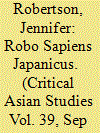|
|
|
Sort Order |
|
|
|
Items / Page
|
|
|
|
|
|
|
| Srl | Item |
| 1 |
ID:
131935


|
|
|
| 2 |
ID:
172574


|
|
|
|
|
| Summary/Abstract |
There has been speculation for some time that unmanned ground vehicles (UGVs) are poised to revolutionize military land operations. These expectations have amplified with recent developments, not least the reported deployment and testing of Russian weaponized UGVs in Syria. Yet when it comes to the operational use of mobile ground-based robots – armed or otherwise – the recent history of the technology can be described as one of promise so far unfulfilled. By tracing past and present efforts to develop and field UGVs – and the enduring challenges that lie therein – this article attempts to gauge the likely impact of such systems in future conflict, as well as their effect on international security more broadly. The article concludes that although UGVs will almost certainly become a major – if not indispensable – feature of future military land operations, they will, similar to other promising militarily relevant technologies before them, continue to produce unrealistic expectations about their impending revolutionary effect.
|
|
|
|
|
|
|
|
|
|
|
|
|
|
|
|
| 3 |
ID:
193470


|
|
|
|
|
| Summary/Abstract |
Building on global advances in artificial emotional intelligence, Japanese companies have increasingly invested in developing social robots with capacities to express and evoke emotion. In some cases, they can even read the emotional expressions of human users. These efforts parallel a broader trend in state support for developing technological solutions to socioeconomic problems, such as social isolation and a deficit in care workers. The rise of companion robots has elicited excitement about potential futures of human–robot existence as well as concerns over data privacy and the loss of inter-human connection, embodying the dynamic emotional dimensions of Japan’s social transformation.
|
|
|
|
|
|
|
|
|
|
|
|
|
|
|
|
| 4 |
ID:
114596


|
|
|
|
|
| Publication |
2012.
|
| Summary/Abstract |
This article sets out to probe the peculiar nexus between democracy and the military use of unmanned systems. To this end, it draws on a critical, 'antinomic' reading of democratic peace theory. Tying into the theoretical scope of research conducted within the democratic distinctiveness programme that emerged out of the democratic peace debate, this entails fathoming out the ways in which democracies are distinct from other regime types. It includes acknowledging that democracies deal with conflicts aggressively too, rather than naïvely taking their supposed general peacefulness at face value. We demonstrate that the same distinctly democratic set of interests and norms that is conventionally taken to be pivotal for democratic peacefulness yields both peaceful and belligerent behavior. That same democracy-specific set of interests and norms is also constitutive of the special appeal unmanned systems hold for democracies. While armed and eventually autonomous systems may thus seem like a 'silver bullet' for democratic decisionmakers today, we argue that, by relying on these systems in an attempt to satisfy the said interests and norms, democracies may end up thwarting them in the long run and render themselves only more war-prone.
|
|
|
|
|
|
|
|
|
|
|
|
|
|
|
|
| 5 |
ID:
162543


|
|
|
|
|
| Summary/Abstract |
This paper contributes a genealogical perspective to the social sciences study of robots in Japan, proposing a widely applicable research on “robot cultures.” The author discusses the corporate and governmental strategies and mechanisms that are shaping a national robot culture through establishing robot “lineages” and a national robot history which can have significant implications for both humans and robots. The paper contributes discussions on monozukuri (manufacturing) and Nihonjinron (theories on “Japaneseness”) to the existing anthropological consideration of robots, by examining links between monozukuri and robots, robot genealogy, popular culture and robots, and different social rituals and sites that help the enculturation of robots. The paper draws attention to the power relations and hegemonies of robot culture which also imply the existence of plurality and diversity that will require further scholarly attention as the robot phenomenon unfolds.
|
|
|
|
|
|
|
|
|
|
|
|
|
|
|
|
| 6 |
ID:
139340


|
|
|
|
|
| Summary/Abstract |
As advanced economies become more automated and digitized, almost all workers will be affected, but some more than others. Those who have what the economists Maarten Goos and Alan Manning call “lovely jobs” will do fine, creating and managing robots and various digital applications and adding lots of value in service sectors such as finance. Those who have what Goos and Manning call “lousy jobs,” however—in sectors such as manufacturing, retail, delivery, or routine office work—will fare less well, facing low pay, short contracts, precarious employment, and outright job loss. Economic inequality across society as a whole is likely to grow, along with demands for increased state expenditures on social services of various kinds—just as the resources to cover such expenditures are dropping because of lower tax contributions from a smaller work force.
|
|
|
|
|
|
|
|
|
|
|
|
|
|
|
|
| 7 |
ID:
121077


|
|
|
|
|
| Publication |
Cambridge, Cosmology Science Publishers, 2011.
|
| Description |
380p.Hbk
|
| Standard Number |
9780982955246
|
|
|
|
|
|
|
|
|
|
|
|
Copies: C:1/I:0,R:0,Q:0
Circulation
| Accession# | Call# | Current Location | Status | Policy | Location |
| 057344 | 523.43/DAV 057344 | Main | On Shelf | General | |
|
|
|
|
| 8 |
ID:
129357


|
|
|
|
|
| Publication |
2012.
|
| Summary/Abstract |
Dassault systemes solid works corp entered the India market in 2002 with a mission to unleash the power of 3D mechanical design.
|
|
|
|
|
|
|
|
|
|
|
|
|
|
|
|
| 9 |
ID:
079844


|
|
|
|
|
| Publication |
2007.
|
| Summary/Abstract |
Japan accounts for nearly 52 percent of the world's share of operational robots and leads the postindustrial world in the development of humanoid robots designed and marketed specifically to enhance and augment human society. Innovation 25, Prime Minister Abe's visionary blueprint for remaking Japanese society by 2025, with the aim of reversing the declining birthrate and accommodating the rapidly aging population, emphasizes the central role that household robots will play in stabilizing core institutions, like the family. In addition to exploring the cultural logic behind the development of autonomous, intelligent, evolutionary humanoid robots, I argue that new bio-and robot technologies are being deployed to reify old or "traditional" values, such as the patriarchal extended family and sociopolitical conservatism.
|
|
|
|
|
|
|
|
|
|
|
|
|
|
|
|
| 10 |
ID:
155815


|
|
|
|
|
| Summary/Abstract |
How will the robot age transform warfare? What geopolitical futures are being imagined by the US military? This article constructs a robotic futurology to examine these crucial questions. Its central concern is how robots – driven by leaps in artificial intelligence and swarming – are rewiring the spaces and logics of US empire, warfare, and geopolitics. The article begins by building a more-than-human geopolitics to de-center the role of humans in conflict and foreground a worldly understanding of robots. The article then analyzes the idea of US empire, before speculating upon how and why robots are materializing new forms of proxy war. A three-part examination of the shifting spaces of US empire then follows: (1) Swarm Wars explores the implications of miniaturized drone swarming; (2) Roboworld investigates how robots are changing US military basing strategy and producing new topological spaces of violence; and (3) The Autogenic Battle-Site reveals how autonomous robots will produce emergent, technologically event-ful sites of security and violence – revolutionizing the battlespace. The conclusion reflects on the rise of a robotic US empire and its consequences for democracy.
|
|
|
|
|
|
|
|
|
|
|
|
|
|
|
|
| 11 |
ID:
109271


|
|
|
| 12 |
ID:
139336


|
|
|
|
|
| Summary/Abstract |
Robots have the potential to greatly improve the quality of our lives at home, at work, and at play. Customized robots working alongside people will create new jobs, improve the quality of existing jobs, and give people more time to focus on what they find interesting, important, and exciting. Commuting to work in driverless cars will allow people to read, reply to e-mails, watch videos, and even nap. After dropping off one passenger, a driverless car will pick up its next rider, coordinating with the other self-driving cars in a system designed to minimize traffic and wait times—and all the while driving more safely and efficiently than humans.
|
|
|
|
|
|
|
|
|
|
|
|
|
|
|
|
| 13 |
ID:
167624


|
|
|
|
|
| Summary/Abstract |
Japan faces a large and rapidly growing care labor shortage. A common assumption is that the government has a choice between alternatives that will shape the future of its institutional elderly care provision: increase the number of migrant caregivers, or use robots and other emergent technologies to substitute for human carers. This article, based on data from seven months’ ethnographic fieldwork at an elderly care home in Japan that was introducing three different types of care robot, challenges this binary framing. The introduction of these robots served to reconfigure care – increasing the amount of work tasks for human caregivers, deskilling aspects of care labor, and raising overall costs. The robots displaced rather than replaced human labor, recalibrating the distance between carers and recipients of care. While such devices may have been intended by politicians and engineers to solve Japan’s care crisis by replacing human caregivers, the reality of robot use makes this unlikely in the foreseeable future. Yet by reconfiguring care and helping overcome linguistic and cultural barriers – rendering it “culturally odorless” – robots may facilitate the introduction of migrant caregivers at the cost of the further precaritization, commodification, and devaluation of care work.
|
|
|
|
|
|
|
|
|
|
|
|
|
|
|
|
| 14 |
ID:
123916


|
|
|
|
|
| Publication |
2013.
|
| Summary/Abstract |
The article explores the trends in surveillance technology for land combat which are categorised as on-demand, enduring and persistent. These trends include small robots and throwbots that provide the ability to see a structure over a wall, old technologies in the form of high technological balloons, and wireless network of micro-mechanical systems. It notes that technological innovations including the proliferation of sensors may change nations' combat capabilities by 2020.
|
|
|
|
|
|
|
|
|
|
|
|
|
|
|
|
| 15 |
ID:
097936


|
|
|
| 16 |
ID:
139337


|
|
|
|
|
| Summary/Abstract |
The debate over what technology does to work, jobs, and wages is as old as the industrial era itself. In the second decade of the nineteenth century, a group of English textile workers called the Luddites protested the introduction of spinning frames and power looms, machines of the nascent Industrial Revolution that threatened to leave them without jobs. Since then, each new burst of technological progress has brought with it another wave of concern about a possible mass displacement of labor.
|
|
|
|
|
|
|
|
|
|
|
|
|
|
|
|
|
|
|
|
|